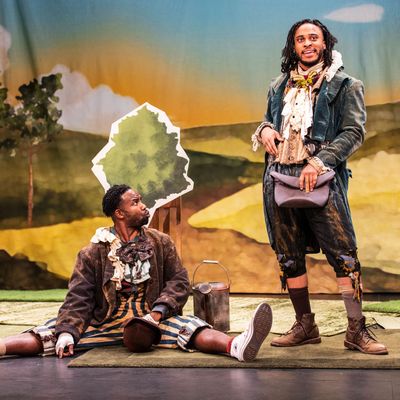
In the “Encores!” revival of 1983’s The Tap Dance Kid — at City Center in the first week of February — the mood stayed sunny for most of the show. Even when grumpy dad William, played by Joshua Henry, wasn’t letting his talented, titular son follow his tap-dancing dreams, the rat-a-tat of happy feet kept the vibes cheerful. Then, at the eleventh hour, William finally revealed why he wouldn’t let young Willie dance. Tap is minstrelsy, he tells his son, and the room turns cold. In his galling, gorgeous breakdown number, Joshua Henry shakes his head ‘no,’ and then keeps shaking his head, letting his features go slack and his eyes roll wide. As he sings, William turns into the thing he hates. He wheels about, he turns about, he jumps Jim Crow.
The secret buried deep at the heart of modern U.S. entertainment is the minstrel show. Cut far enough into show business, your blade comes up covered in burnt cork. In the 19th century, white performers did it; eventually Black performers did it too; and basically everybody watched it. Traditions met, melded, became conventions. The first talking picture was built around it. Minstrelsy may be invisible to us now, but its complex legacy is down there in the water table, still seeping into every aspect of popular culture. When William dares to name it in The Tap Dance Kid, it’s like watching the hand write with fire on the wall. The audience, the show, the very fact of the show have been weighed and found wanting.
Dave Harris’s Tambo & Bones at Playwrights Horizons wants that same audience-targeting effect, but instead of dynamiting his show at the end, Harris explodes it at the beginning. There’s power in that — but danger too.
A red curtain rises on a minstrel show. Two men in tattered finery clown and caper: Tambo (W. Tré Davis) is trying to get some shut-eye under the set’s fake trees; Bones (Tyler Fauntleroy) wants to get a shiny quarter (or three) from the audience. First Bones tries to raise funds by claiming he has a sick son, but when that doesn’t work, he whips out a knife and offers to hurt himself.
BONES: Imma put on a show! See, I tried to tell them a sad story. Appeal to they sense of Emily.
TAMBO: They sense of Emily?
BONES: They sense of Emily.
TAMBO: They sense of empathy?
BONES: Empathy, yeah! I tried to appeal to they sense of empathy. But that ain’t work. Sooooooooo Imma put on a different type of show.
Tambo tuts at Bones’s naivete. “You gotta deliver a treatise on race in America,” he says, nodding wisely. Even when Tambo gives his speech, though, the crux is still Black suffering. Whichever Black man doesn’t learn to make money on the way their “tears sounded like music,” well, he will become poor. Also, Obama! The audience laughs, but Tambo and Bones seem unhappy with that response. Then the pair leaps forward in time to become modern-day rap superstars. A white producer has given them a record contract (“Ya gotta good story, we like your appeal”); again, they’ve traded pain for profit, and, after several sly songs written with Justin Ellington, the audience applauds wildly. But that’s not the response they want either. A second time-jump to a future without white people, though, one where Tambo and Bones have overseen a Caucasian genocide, results in the kind of shocked quiet that the show has been aiming at all along. Laugh at this; clap for this. They dare you.
In the 19th century, Tambo (who played a tambourine) and Mr. Bones were the minstrel show’s “end men,” the folk-hero patter-comedians who cracked jokes at the show’s expense from either side of the proscenium. And at first, aided by director Taylor Reynolds, Davis and Fauntleroy go broad — at one point, they go into the audience, and they get roars just for their coordinated tiptoeing. Just as you start thinking, Huh, I wonder what these end men are going to make fun of, the penny drops, and you notice your fellow audience members all around you. Tambo and Bones are on either side bracketing us. A Playwrights Horizons audience, at least the one I was in at a Saturday matinee, is overwhelmingly white; in fact Harris’s strategy works best if the room is unbalanced in that way.
Tambo & Bones is part of a satirical school that employs a “Who’s laughing now?” structure in which white theatergoers’ entertainment (and attendant laughter, responses, etc.) provides both the subject and the medium of its critique. In Slave Play, playwright Jeremy O. Harris (no relation to Dave) manipulated a Broadway house like a prepared piano: He orchestrated the way different racial groups in his audience either fell silent or cracked up — as well as the way they heard each other doing so. Jackie Sibblies Drury’s elegant Pulitzer Prize–winning Fairview accomplished something similar, though she went farther than either of the Harrises by asking the white audience to go onstage for a portion of the play. She made separation observable as well as audible.
Tambo & Bones, however, fades in its coda in a way these other two plays do not. Its deepest thrusts are made in the blistering first two sections, and while the third is certainly trying hard for the coup-de-grace — any mention of genocide is sobering — Harris leaves this part’s most powerful statements in the stage directions where we don’t see them. “There is no line between actor and character / between audience and actor. We are responsible for everything we have ever done,” goes one such lyrical stage direction, which is impressive to read but unplayable in this production. The weight of those early minstrelsy images is also difficult to get over. Harris is trying to accelerate past them, to use their gravity as a slingshot into even more extreme territory, but they keep pulling the show backwards. His purified Afrofuture keeps paling in the bilious light of the real past.
In an essay for the Roundabout Theatre Company, Dave Harris wrote about his intoxication with the way the Black nationalist poet-playwright Amiri Baraka fantasized about anti-white violence. The third chunk of Tambo & Bones was clearly written under Baraka’s star, governed by his fire. Yet Harris’s own lacerating stage poetry slices deepest when it is driving terrifyingly inward. “It’s possible that the idea that good art asks questions is a white liberal lie designed to breed passivity,” he wrote in the essay, and you feel that complex contempt all through the first two sections, whether for his (or anyone’s) attempt to write art-as-discourse, or for this specific theater where he’s working, or for the attempt to communicate with white people who have not listened for generations. At one point, Tambo and Bones beat Harris’s own effigy, stomping on his puppet face and tearing him apart. It’s a staggering moment, and revealing. They wheel about, they turn about, they jump Jim Crow.
Tambo & Bones is playing at Playwrights Horizons through February 27.





